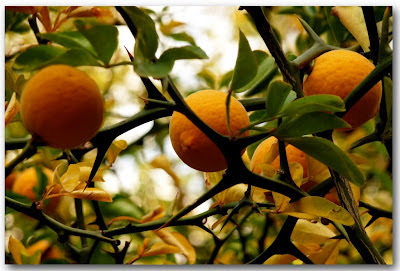Blood plants
Have you ever wished that you could surround your garden in a fortress of barbwire? For many it would be to prevent forgaging deer but mine would be to stop kids cutting through the garden. Whatever your reasons are, barbwire isn't the most glamorous look but but mother nature has come up with some plants that you soon won't forget.
We recently took delivery of a particularly nasty but delightfully curious plant this week that not only draws blood but takes off a pound of flesh in the process. Poncirus trifoliata 'Flying dragon' or also known as 'Hardy Orange' has left its mark on many a person. The curved thorns are remenisant of the hooked tallons from a bird of prey, while the contorted branching enable it to snag you as the claws come from different directions. The green stems gives pleasure (from afar) during the winter but the small oranges it produces is its main attribute. They say the flowers are fragrant but who in their right mind would stick their face into the plant to get a sniff!
Barberries have always commanded respect when handling as there thorns have a habit of sticking you then embedded in your finger to leave a constant reminder of the encounter. Many a night has been spent doing surgery in the bathroom with twisters digging out the tip of a spine. However the Julianne barberries replaced its stickers with harpoons fit for whale hunting. 'William Penn' (B. x gladwynesis) is a smaller cousin only getting 4ft with a slightly wider spread but still looks like a bed of nails. Even armed with implements of torture it still produces beauty bright yellow flowers in spring held against glossy evergreen foliage. I once knew a nurseryman who wouldn't tell his crew when it was time to prune these guys as he knew many would disappear for the day in fear.
When it comes to off loading trucks, hollies have a way of clearing the labor pool and rightly so when you have to deal with the dwarf Chinese Holly 'Rotunda'. This evergreen beast makes other hollies look like soft and cuddly kittens with its razor sharp needles perched around its foliage. Theres no easy way to grab the plant in the container without being reminded that its bite is just as bad as its bark. It's saving grace is that its a dwarf, up to 3ft high with a wider spread making it useful for foundation plantings or barrier plantings around Hosta's or other deer favorites. A popular practise in England was to plant them around windows to prevent break-ins, or at least, know your night visitor has just learnt to respect hollies!
Don't let these plants prickly dispositions put you off, part of there wonder is the shock and awe they bring to a garden setting. 'Every rose has a thorn' but every plant has its use, your job is to find that use!
We recently took delivery of a particularly nasty but delightfully curious plant this week that not only draws blood but takes off a pound of flesh in the process. Poncirus trifoliata 'Flying dragon' or also known as 'Hardy Orange' has left its mark on many a person. The curved thorns are remenisant of the hooked tallons from a bird of prey, while the contorted branching enable it to snag you as the claws come from different directions. The green stems gives pleasure (from afar) during the winter but the small oranges it produces is its main attribute. They say the flowers are fragrant but who in their right mind would stick their face into the plant to get a sniff!
 |
| Flickr Creative Common License - M Martin Vicente |
Barberries have always commanded respect when handling as there thorns have a habit of sticking you then embedded in your finger to leave a constant reminder of the encounter. Many a night has been spent doing surgery in the bathroom with twisters digging out the tip of a spine. However the Julianne barberries replaced its stickers with harpoons fit for whale hunting. 'William Penn' (B. x gladwynesis) is a smaller cousin only getting 4ft with a slightly wider spread but still looks like a bed of nails. Even armed with implements of torture it still produces beauty bright yellow flowers in spring held against glossy evergreen foliage. I once knew a nurseryman who wouldn't tell his crew when it was time to prune these guys as he knew many would disappear for the day in fear.
When it comes to off loading trucks, hollies have a way of clearing the labor pool and rightly so when you have to deal with the dwarf Chinese Holly 'Rotunda'. This evergreen beast makes other hollies look like soft and cuddly kittens with its razor sharp needles perched around its foliage. Theres no easy way to grab the plant in the container without being reminded that its bite is just as bad as its bark. It's saving grace is that its a dwarf, up to 3ft high with a wider spread making it useful for foundation plantings or barrier plantings around Hosta's or other deer favorites. A popular practise in England was to plant them around windows to prevent break-ins, or at least, know your night visitor has just learnt to respect hollies!
Don't let these plants prickly dispositions put you off, part of there wonder is the shock and awe they bring to a garden setting. 'Every rose has a thorn' but every plant has its use, your job is to find that use!